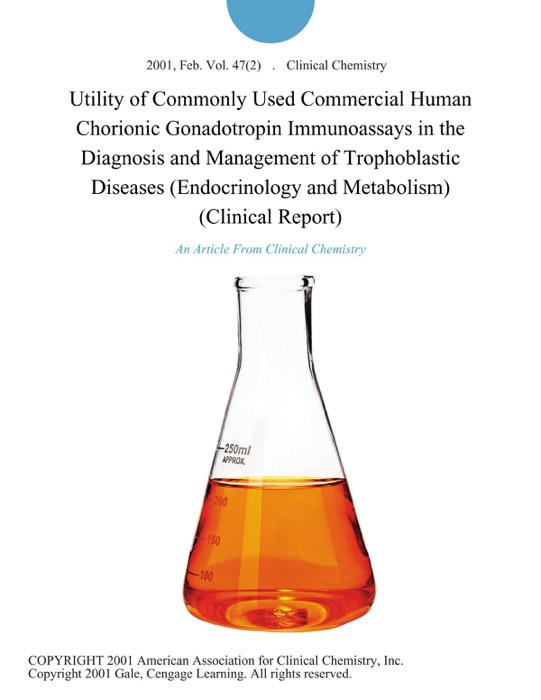(DOWNLOAD) "Utility of Commonly Used Commercial Human Chorionic Gonadotropin Immunoassays in the Diagnosis and Management of Trophoblastic Diseases (Endocrinology and Metabolism) (Clinical Report)" by Clinical Chemistry * eBook PDF Kindle ePub Free

eBook details
- Title: Utility of Commonly Used Commercial Human Chorionic Gonadotropin Immunoassays in the Diagnosis and Management of Trophoblastic Diseases (Endocrinology and Metabolism) (Clinical Report)
- Author : Clinical Chemistry
- Release Date : January 01, 2001
- Genre: Chemistry,Books,Science & Nature,
- Pages : * pages
- Size : 224 KB
Description
Human chorionic gonadotropin (hCG) is composed of two peptides, the a and [beta] subunits, joined noncovalently. Approximately 30% of the molecular weight of hCG comprises carbohydrate side chains: four N-linked oligosaccharide and four O-linked oligosaccharides. The hCG a and [beta] subunits are heterogeneous in both peptide and oligosaccharide side chain structures (1, 2). Ordinary hCG [alpha] and [beta] dimer with no cleavages, monoantennary or biantennary N-linked oligosaccharides, and trisaccharide and tetrasaccharide O-linked oligosaccharides) is the principal form of hCG in serum during normal pregnancy. Ordinary hCG is accompanied by small and varying amounts of nicked hCG (cleaved on the [beta] subunit, between residues 47 and 48), hyperglycosylated hCG (hCG with an abundance of larger or triantennary N-linked oligosaccharides and hexasaccharide O-linked oligosaccharides), nicked and hyperglycosylated hCG, free [beta] subunit, nicked free [beta] subunit, free a subunit, and large free a subunit (a subunit with triantennary N-linked oligosaccharides) (1, 2). Commercial hCG (or hCG[beta] assays all detect ordinary hCG, and to various extents detect nicked hCG, hyperglycosylated hCG, nicked and hyperglycosylated hCG, and nicked and nonnicked free [beta] subunit. None of the commercial hCG (or hCG[beta] methods detect either form of free [alpha] subunit (2). With the preponderance of ordinary hCG in normal pregnancy serum, the ability of the assay to fully detect nicked hCG, hyperglycosylated hCG, nicked and hyperglycosylated hCG, and nicked and nonnicked free [beta] subunit may make only a small difference to the immunoassay results and to the utility of the assay for pregnancy testing (1, 3, 4). Trophoblastic diseases include complete and partial hydatidiform mole, postmolar tumor, gestational choriocarcinoma, testicular choriocarcinoma, and placental site trophoblastic disease. These are also major sources of hCG. Precise hCG determinations are crucial in patients with trophoblastic diseases to assess the mass of tumor, the successful treatment of malignancy, or recurrence or persistence of disease [beta]-5). In trophoblastic diseases, hyperglycosylated hCG, nicked hCG, hyperglycosylated and nicked hCG, or nicked or nonnicked free [beta] subunit may be the principal source of immunoreactivity in serum (2-7). Additional hCG variants are found in patients with trophoblastic diseases. These include nicked hCG missing the [beta] subunit C-terminal peptide, residues 92-145, and alternatively nicked hCG (cleaved at [beta]43-44 or [beta]44-45) (1). The inability of commercial hCG tests to fully detect these hCG variants has led to failure to detect persistent or recurrent trophoblastic diseases, requiring urgent chemotherapy or other surgery (4, 8, 9).